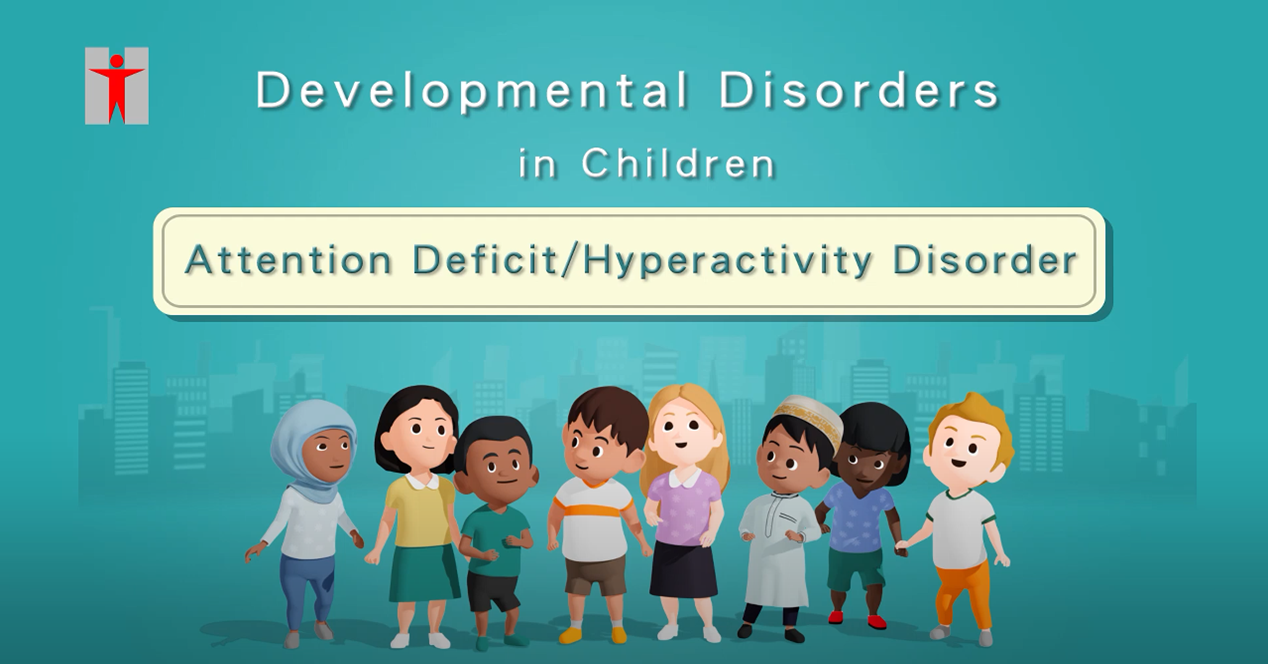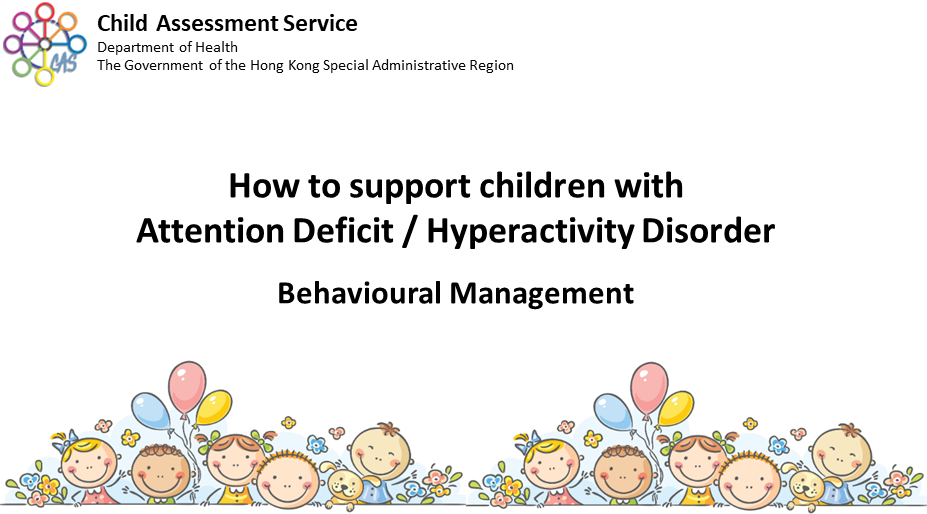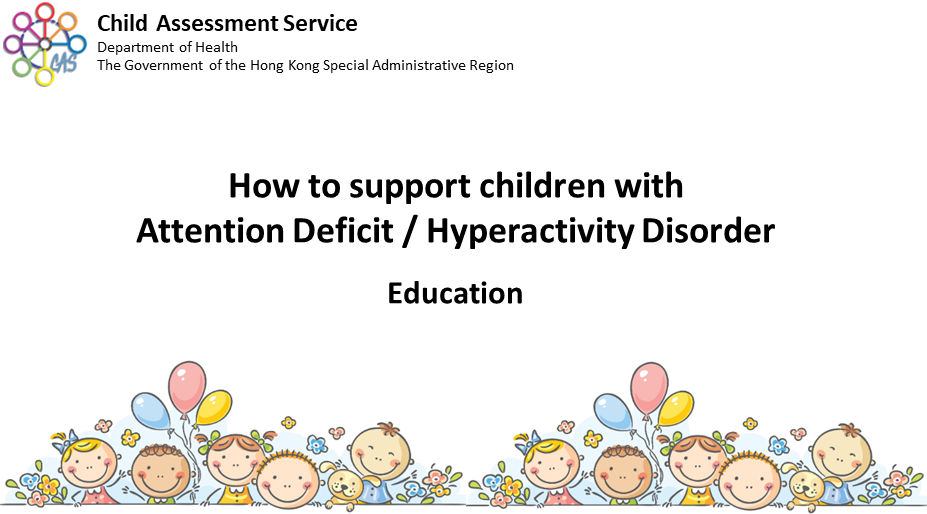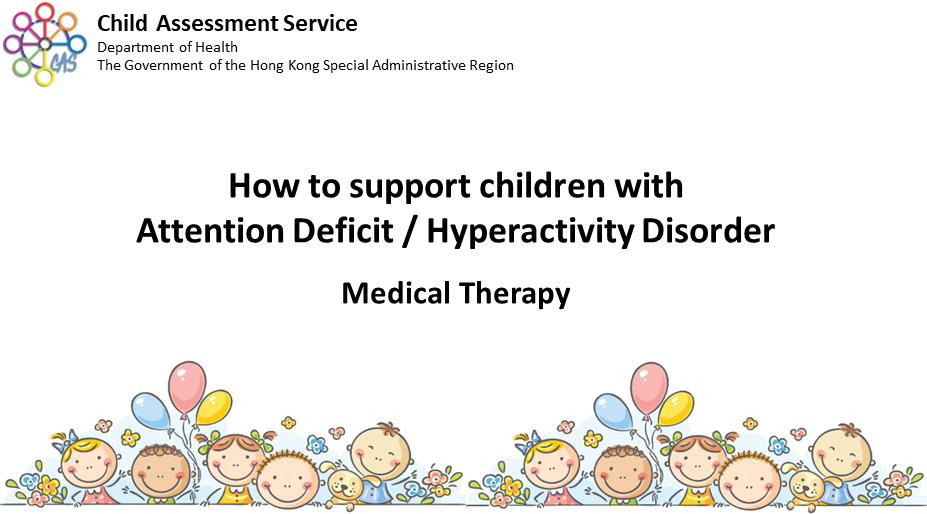Attention Deficit/Hyperactivity Disorder
The core symptoms of Attention-Deficit/Hyperactivity Disorder (AD/HD) are, as the name implies, inattentiveness, hyperactivity and impulsivity. These symptoms cause difficulties in learning and interpersonal relationships, which may lead to emotional problems or low self-esteem, resulting in multiple functional problems.
Inattention:
Children with AD/HD find it difficult to sustain attention in activities, compared with children of similar age. They are easily distracted by the environment and do not seem to listen. They have difficulty in following
through instructions, completing tasks and organizing activities. They are forgetful and often lose personal belongings.
Hyperactivity / Impulsivity:
Children with AD/HD are more active compared with children of the same age. They are often on the go. They squirm in their seats and may even leave seats. They talk excessively and have difficulty engaging in activities
quietly. They tend to be impatient and impulsive, having difficulty queuing or waiting for their turn. They also tend to interrupt or blurt out answers before the questions are completed.
Clinical features of AD/HD evolve with the children’s age:
-
Infancy and preschool age:
The core feature of children with AD/HD during this period is hyperactivity. They are energetic and are often running about or climbing around. Some children may cry and lose temper easily. They may have greater emotional response to events and become excited or angry easily. Some may have sleeping problems as well. -
School age:
During this period, problems related to inattention become increasingly obvious. Their inattention in class affect their learning and academic performance. They are impulsive, weak in self-control and less compliant. These lead to problems in social relationship and conflict with peers. Some children may also show oppositional, risk-taking and/or dangerous behaviour. -
Late childhood and early adolescence:
In late childhood and early adolescence, although the severity of hyperactivity may decline, features of inattention and impulsivity often remain. New problems may emerge, including frequent engagement in interpersonal conflict, aggressive behaviour or addiction. -
Adulthood:
In adulthood, inattention and impulsivity are still core symptoms of AD/HD. Adults with AD/HD may have difficulty concentrating at work. Symptoms of distractibility, disorganization, inefficiency, impatience and impulsivity may persist.
Epidemiological data suggests that AD/HD affects about 6% of children, with a male preponderance of around 2 boys to 1 girl being affected. For adults with AD/HD, the prevalence is around 2.5%.
The prevalence of AD/HD in Hong Kong is similar to that in other countries. According to the recent statistics from Child Assessment Service of the Department of Health, among children newly diagnosed with AD/HD in 2020, the gender ratio was around 3 boys to 1 girl. The exact prevalence of AD/HD in Hong Kong requires further investigation.
Research has demonstrated that several important areas of the brain are differently activated in children with AD/HD. These include the pre-frontal regions, the basal ganglia and the cerebellum. Since areas of the brain responsible for executive function are affected, children’s working memory, attention, control of behaviour and emotions, and organization skills are affected.
The exact cause of AD/HD has yet to be elucidated. Research has suggested that genetic factors play an important role in AD/HD. Maternal smoking and alcohol intake during pregnancy, prematurity, low birth weight, history of encephalitis, lead poisoning, abnormalities in metabolism, epilepsy and brain injury have been shown to be risk factors for AD/HD.
Although biological factors play an important role in the manifestation of the condition, psychosocial and environmental factors (including family support, school accommodation and societal acceptance) affect its severity and impact on children’s daily function.
Children with AD/HD may also have other developmental disorders, such as autism spectrum disorder, developmental language disorder, dyslexia, developmental coordination disorder, oppositional defiant disorder or other behavioural and emotional problems.
The treatment strategies for children with AD/HD vary according to age. As shown from numerous international studies, medical therapy and behavioural therapy are proven to be effective strategies. For preschool children under six years of age, behavioural therapy is recommended as the initial treatment. If the child’s condition does not improve with behavioural therapy, medical therapy may be needed. For school-age children age six years or above and for adolescents with more severe symptoms, medical therapy is the first-line treatment. Medical therapy is very effective in controlling the core symptoms of AD/HD, improving attention and reducing hyperactive behaviour. When combines with behavioural therapy and educational support, it can improve learning and reduce behavioural problems of these children.
- Medical therapy:
Medication is the first line of treatment for school-age children and adolescents with more severe AD/HD symptoms. Stimulant medication is the first choice. It works by increasing the neurotransmitter, dopamine, in the central nervous system, thereby improving attention. The most commonly prescribed medication is methylphenidate (e.g. Ritalin and Concerta). Research has shown that 75% of the patients showed significant improvement in attention after medication. Hyperactivity and impulsive behaviours were largely reduced as well.
Common side effects include poor appetite, weight loss, sleep disturbance, abdominal pain and irritability. These side effects are usually mild, short-lived and responsive to dosing and timing adjustment. Most children are able to adapt to the medication. Second line medications may sometimes be considered. These are the non-stimulants, which include selective norepinephrine reuptake inhibitors such as atomoxetine (e.g. Strattera).
- Behavioural therapy:
Behavioural therapy mainly targeted on the behavioural problems of children with AD/HD. These include behavioural, as well as learning and social difficulties. Behavioural therapy is based on learning theories and grounded on the belief that behaviour is formed by experiential learning and modeling, in addition to good parent-child relationship. Thus, children’s condition can be improved by a systematic way of discipline. Behavioural therapy usually involves: (1) defining the behavioural problem by observation and recording of the behaviour, including the time, place and frequency of occurrence, other’s reaction etc.; (2) analyzing the antecedents and consequences of the behaviour; and (3) through changing these antecedents and consequences by facilitative environment and proper use of reinforcement/punishment etc., enable the children to learn and increase appropriate behaviours and decrease inappropriate behaviours. Since children with AD/HD has different needs at different stages, review of the child’s condition and change of strategies should be done regularly.
Good parent-child relationships are keys to success. Teaching children on proper ways to handle emotions, effective problem solving skills, and establishment of good living habits are also beneficial and important.
- Educational support:
Classroom management and academic accommodations such as regular breaks between learning tasks, clear verbal and written instructions, breaking tasks into smaller steps, visual aids and a facilitative environment (such as reducing noise levels, special seat arrangement) may enhance their ability to learn and focus.
The Child Assessment Service of the Department of Health offers behavioural and developmental assessment for children with AD/HD symptoms, as well as interim support for the family including parent workshops and parenting skill training groups. Under the Hospital Authority, Child and Adolescent Mental Health Services and Departments of Paediatrics and Adolescent Medicine provide medical and behavioural treatment for children with AD/HD.
In additional, psychiatrists, paediatricians and general practitioners in private practice may prescribe medication for children with AD/HD. In schools, support is provided to teachers and children by school social workers and educational psychologists. Parents/Relatives Resource Centres and other related services also offer training programs and activities for children with AD/HD and their families.
Research has demonstrated that the symptoms of AD/HD persist to adolescence in 80% of children, and to adulthood in 65%. However, the extent to which an individual can cope or make adjustments in daily life and occupation choice depends on many other factors, including the severity and type of symptoms exhibited, the severity and number of associated conditions, the individual’s intelligence, the family situation and treatments received.
Education Bureau: Integrated Education and Special Education Information Online
http://sense.edb.gov.hk/en/index.html
Kwai Chung Hospital ADHD resources
Hong Kong Association For AD/HD
American Academy of Pediatrics
http://www.aap.org/healthtopics/adhd.cfm
American Psychological Association
http://www.apa.org/topics/topicadhd.html
Attention Deficit Disorder Association
Centres for Disease Control and Prevention
https://www.cdc.gov/ncbddd/adhd/data.html
Children and Adults with Attention Deficit / Hyperactivity Disorder
- Subcommittee on Attention-Deficit/Hyperactivity Disorder, Steering Committee on Quality Improvement and Management, American Academy of Pediatrics. (2011). ADHD: Clinical Practice Guideline for the Diagnosis, Evaluation, and Treatment of Attention-Deficit/Hyperactivity Disorder in Children and Adolescents, Pediatrics, 128(5), 1007-1022.
- Evans, S., Owens, J. S., & Bunford, N. (2014). Evidence-Based Psychosocial Treatments for Children and Adolescents with Attention-Deficit/Hyperactivity Disorder, Journal of Clinical Child & Adolescent Psychology, 43(4), 527-551.
- Barkley, R. A. (2002). Psychosocial treatments for attention-deficit/hyperactivity disorder in children. Journal of Clinical Psychiatry, 63(12), 36-43.
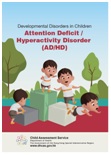
Short Factsheet
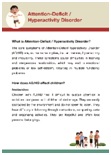
Long Factsheet
